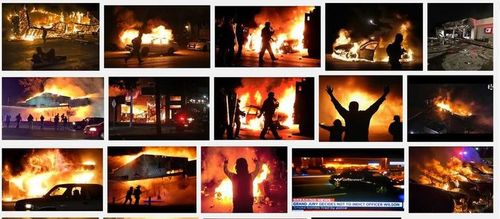
How Chicago’s Richie Daley started the banlieueification of America’s suburbs
By Steve Sailer
07/08/2015
With the Obama Administration upping its efforts to dump the hot potato of inner city poor people on the suburbs and small towns of America in the name of making hundreds of billions in real estate profits for well-connected insiders in the name of social justice, it’s worth recalling the surprising figure who did so much to promote the Paris System (rich people in the center, poor people on the fringes) in America.
By, say, 1990, it was clear that a huge difference between Paris and typical American big cities such as Chicago was that Paris smartly warehoused its nonwhite underclass in remote suburban banlieues so they wouldn’t pester and depress Paris’s white upper crust in the magnificent inner city.
In contrast, unworldly America had allowed the term “inner city” to become a synonym for poverty, public housing, welfare, and crime. For example, in Chicago, vast, foreboding public housing complexes loomed in what would otherwise be prime real estate, such as Cabrini Green a mile inland from the Gold Coast and the Robert Taylor Homes on south State Street.
A key figure in bringing home the message “They do it better in Paris” was Chicago Mayor Richard M. Daley during his long tenure from 1989-2011. Daley the Younger couldn’t be dismissed as a snob or a social climber, so his long public love affair with Paris and his plans for making Chicago more like Paris garnered much attention among people who make money off urban real estate. For example, here’s a 1999 article from the Philadelphia Inquirer:
A Midwestern ‘City Of Light’Chicago’s Mayor Daley Is Not So Secretly In Love with Paris. And Signs Of That Are Springing Up All Over Town.
By Raad Cawthon, INQUIRER STAFF WRITER POSTED: December 19, 1999
CHICAGO — The joke is that every time Mayor Richard M. Daley goes to Paris, he returns with another idea to make Chicago more beautiful.
First, it was flowers, spilling from hundreds of metal baskets hanging from lampposts or crammed into huge planters in the medians of the city’s major streets. Along with the flowers came the trees — 135,000 planted in the last decade.
Then it was wrought iron — wrought-iron fencing erected by the mile, new bridges sporting wrought-iron trim and obelisks and sculptures, wrought-iron lampposts with fanciful curlicues.
Now, it’s lights. …
The seasonal lights eventually will go. What will continue is Daley’s campaign for the nightly illumination of as many downtown facades as possible — to create a Midwestern “City of Light.” …
The overall result is that Chicago — once noted for its smoky industry, sprawling stockyards, and rough-hewn character — now looks sleek and well-tended.
And the nation is noticing it and, to some extent, trying to emulate it.
“I haven’t been [to Chicago] in about two years, but everybody comes back raving about it,” said Paul Levy, executive director of the Central Philadelphia Development District. “Landscaping is where Chicago has a real advantage over everyone else.”
Daley has made the cityscape a priority for much of the ’90s, but it wasn’t until 1996, when the Democratic National Convention came to town, that his policies began to pay big dividends. Through the world’s television cameras, Chicago’s beautiful urban stage helped erase memories of the last convention to visit, the Democrats’ riot-scarred hatefest of 1968.
Since ’96, improved aesthetics have been credited with everything from increased downtown retail revenues to an influx of suburbanites moving back to the city.
“He has put design on the agenda,” Blair Kamin, architecture critic for the Chicago Tribune, said of the mayor. “He cares about it. He has three architects in his cabinet.” …
On numerous visits to Chicago, Rendell conferred with Daley and saw, firsthand, the impact of spending on beautification: With convention business up and tourism climbing, Chicago clearly was on an upswing.
Daley urged Rendell to follow his example and aggressively seek a political convention to showcase Philadelphia to the world. …
The critics noted that, while the city’s beautification halted at the United Center, Madison Street kept going, deep into an impoverished area of West Chicago.
Still, that redevelopment has helped stabilize gentrification that was already taking place along Madison and adjacent Randolph Streets. In fact, Randolph has emerged as the city’s latest “restaurant row,” while Madison bustles as a result of the conversion of commercial lofts to apartments, which began before 1996 but was spurred by city improvements.
“One hundred and twenty thousand residents have moved into downtown lofts in the last 10 years, many in that area,” said Perry Duis, a historian at the University of Illinois at Chicago.
Daley’s critics also complain that the mayor’s tastes are pedestrian, that he has “sanitized” the look of the city.
And there is no arguing that some projects have verged on disaster, perhaps most memorably the gay pride-themed “improvements” to the Lakeview neighborhood that had to be scaled back after an outcry from the area’s predominantly gay community. …
This has come to be called the “architecture of reassurance,” a converting of the cityscape from a dark and dangerous place to one of light, people and excitement.
Of course, what goes unmentioned in this article is the stick that complemented Daley’s carrots: the demolition of public housing projects with easy access to downtown, and the scattering of their denizens, clutching Section 8 vouchers, to inner suburbs or small towns.
